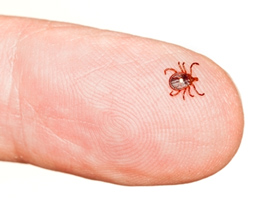Lyme disease is caused by the bacteria Borrelia Burgdorferi or Borrelia Miyamotoi (tick borne relapsing fever). This disease was first discovered in the 80s and is often categorized as acute disease vs chronic disease. Lyme disease has been documented in all 50 states, so even states with relatively low tick populations are not spared. Acute Lyme is fairly well recognized and treated in mainstream medicine, but there is contention over the existence of chronic Lyme disease and other tick-borne co-infections. This is because the symptoms are often migratory and span multiple body systems. Because of this lack of clear diagnostic tools and guidelines, it has been estimated that undiagnosed Lyme disease costs Americans $712 million to 1.3 billion dollars per year in treatment and medical visits (Aucott 2015). Lyme disease profoundly affects both patients and loved ones.
Symptoms
- Symptoms vary depending on each person and how long the bacteria have been in the body. Most common symptoms are as follows:
- Swollen, painful joints; neuropathies; migraines; POTS and changes in heart rhythms and rate; sudden new onset anxiety; brain fog; fatigue; mood changes, GI symptoms.
- Many of the symptoms are often migratory in nature (if pain) or come and go with seemingly no reason.
Testing
- Testing is notoriously difficult with Lyme because of its unique ability to change shape when exposed to antibiotics. CDC criteria is very exclusive and oftentimes does not recognize the changes in the immune system that Lyme can cause.
- General labs:
- CD57 – this is a particular white blood cell that is “spent” fighting Lyme and other diseases. If low, likely an infection is causing symptoms.
- Western blot – Not very specific. Most often will only detect 84% of positive Lyme cases.
- Antibodies to Borrelia – also not super specific and Borrelia is particularly good at avoiding the immune system and not “following the rules” of the immune system.
- Specialized labs:
- Igenix – We use Igenix laboratory as they are the gold standard of Lyme detection. Their testing is much more sensitive than the general labs. Average sensitivity is closer to 90-96%. This means that the test can catch up to 12% of Lyme cases missed by standard western blot testing. https://igenex.com/the-igenex-advantage/
Treatment
- Prevention is the best cure! Here are some handy tips from Igenix on how to prevent Lyme disease. https://cdn.igenex.com/wp-content/uploads/2022-Lyme-Disease-Awareness-Month-Tips.pdf
- Herbal treatment – There are many herbs including Japanese Knotweed and Cat’s Claw that are effective in treating Lyme. Herbal treatments are often easier to adjust the dosing to tolerance as well as easier to take long term.
- Antibiotics – doxycycline is the antibiotic of choice for Lyme.
- Ozone therapy – ozone kills bacteria, viruses, and fungi.
- Treat other supportive body systems: address the thyroid, adrenal glands, vitamin levels, and multiple other organ systems to ensure your body can fight the Lyme.
Lyme disease does not have to be forever. Treatment can take a long time, but there are many examples of patients improving their quality of life when diagnosed and treated appropriately.
Dr. Falkner has attended ILADS (International Lyme and Associated Diseases Society) conferences as well as has years of experience treating Lyme both naturally and with antibiotics.

